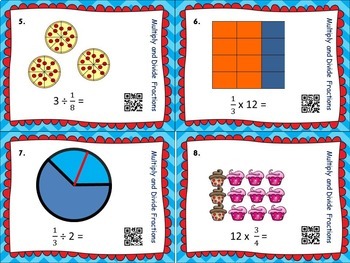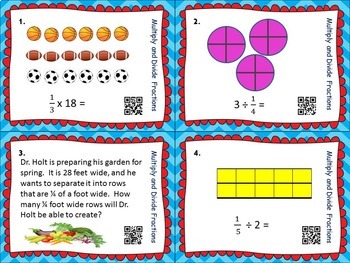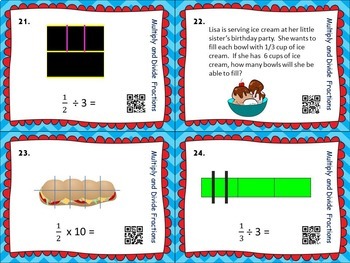Fractions Multiply and Divide Fractions TASK CARDS
- PDF
- Easel Activity
Also included in
- Need more practice multiplying and dividing fractions? This bundle includes 3 ways for your students to practice and master the skill of Multiplying and Dividing Fractions:BINGO: Print and laminate the 35 included Bingo cards and then project slides showing different representations of multiplyingPrice $6.40Original Price $9.20Save $2.80
- **ALL SETS NOW FORMATTED FOR YOUR DISTANCE LEARNING NEEDS!**Need an independent way for students to master math objectives? Each Set of Task Cards include 24-28 cards and come with a student response sheet and an answer key. All are in color and include many different visuals. All also include QR CPrice $75.00Original Price $108.10Save $33.10
Description
Need more practice multiplying and dividing fractions? Students will use pictoral representations to multiply or divide fractions by fractions or fractions by whole numbers. They may use the QR Code on each card to check their own answers. Or, pass cards around your classroom from one student to another and students will solve equations and record on the included answer sheet.
Both ways are great reviews of Multiplying and Dividing Fractions.
Also included: Easel Assessment - Multiply Unit Fractions by Whole Numbers. Use it to evaluate your students' multiplying fractions skills!
*****************************************************************************
Other great resources
Multiple Meaning Words Vocabulary Cards
*****************************************************************************
Customer Tips:
How to get TPT credit to use on future purchases:
• Please go to your My Purchases page (you may need to login). Beside each purchase you'll see a Provide Feedback button. Simply click it and you will be taken to a page where you can give a quick rating and leave a short comment for the product. Each time you give feedback, TPT gives you feedback credits that you use to lower the cost of your future purchases. I value your feedback greatly as it helps me determine which products are most valuable for your classroom so I can create more for you.
Be the first to know about my new discounts, freebies and product launches:
• Look for the green star next to my store logo and click it to become a follower. Voila! You will now receive email updates about this store.
**********************************************************************








